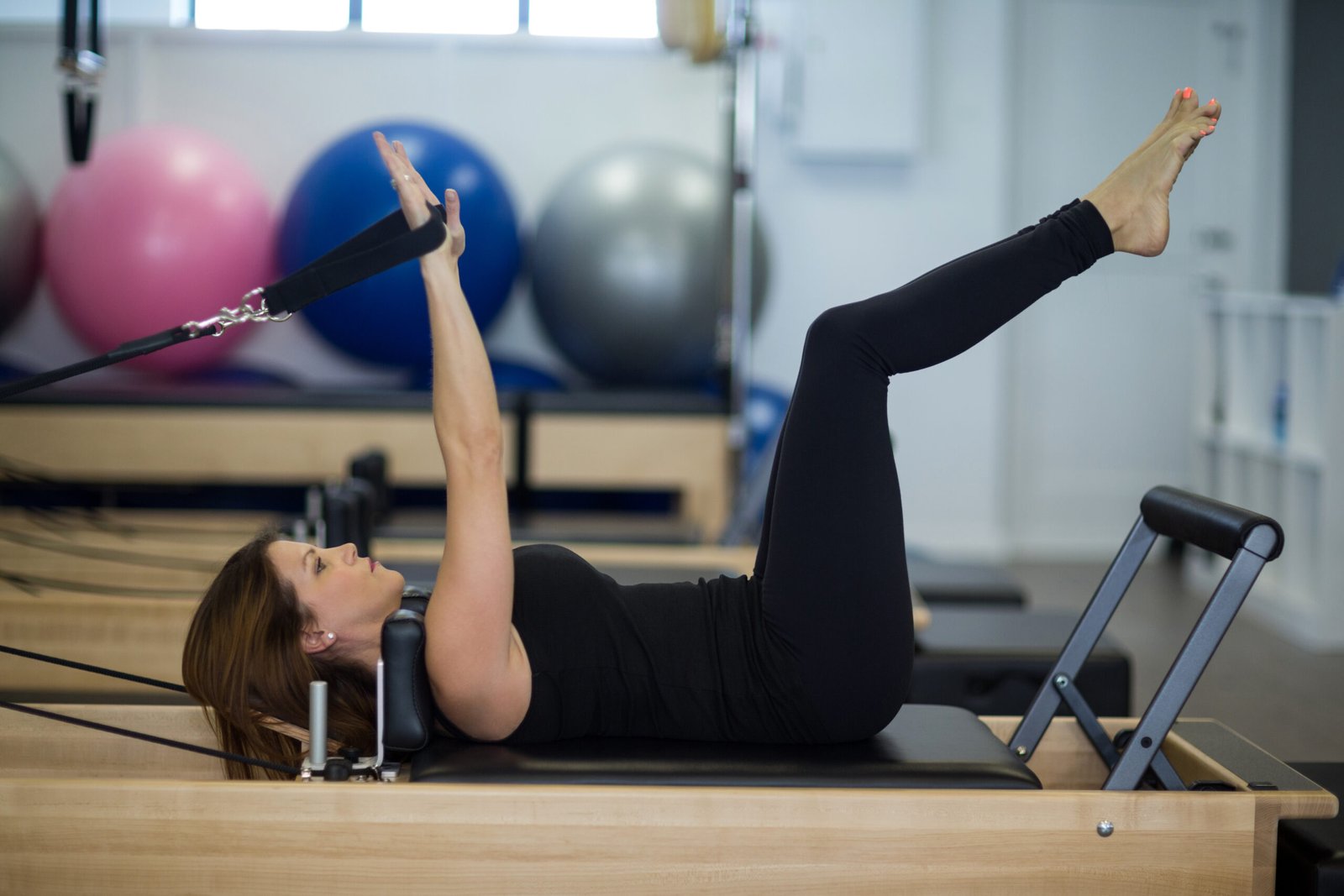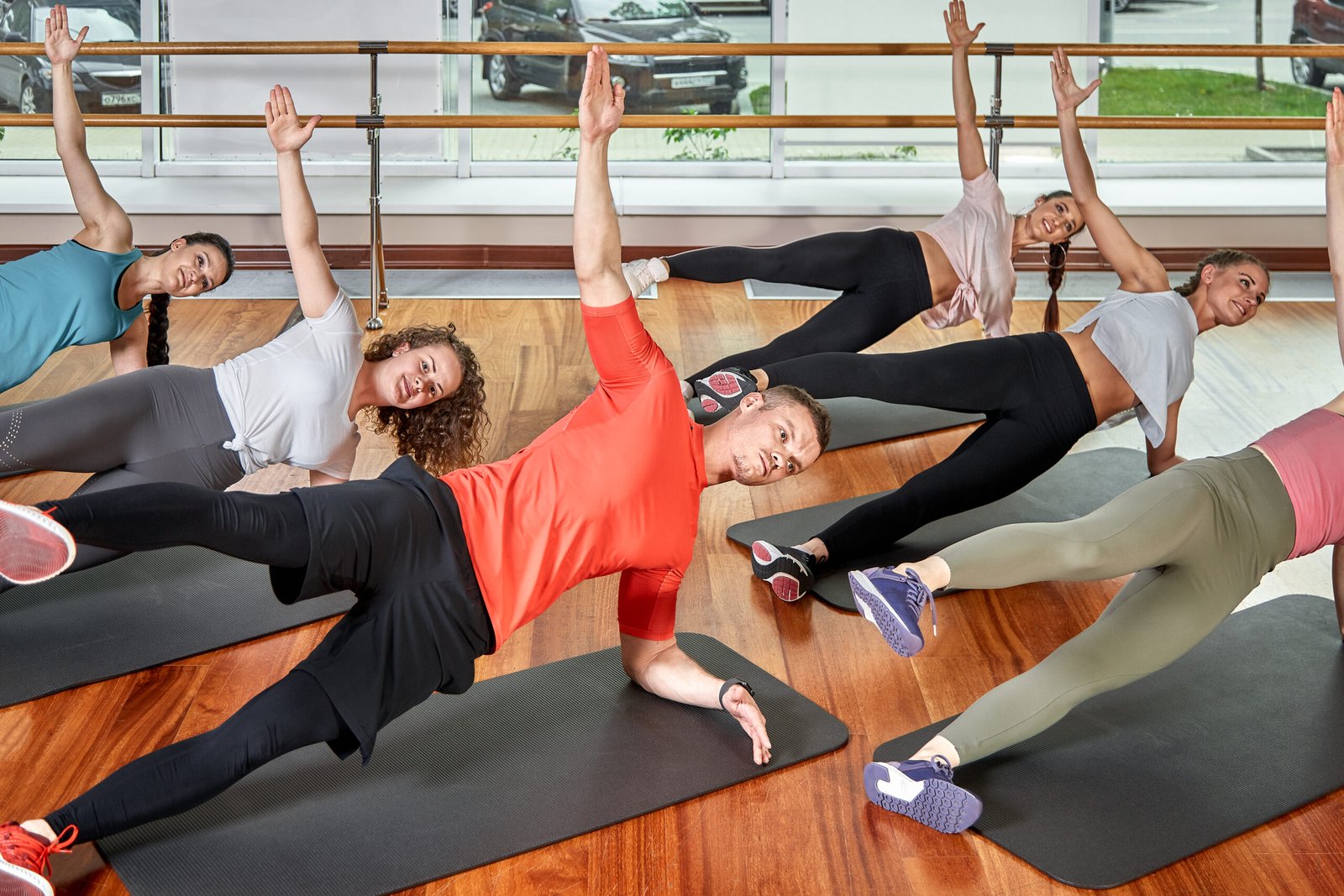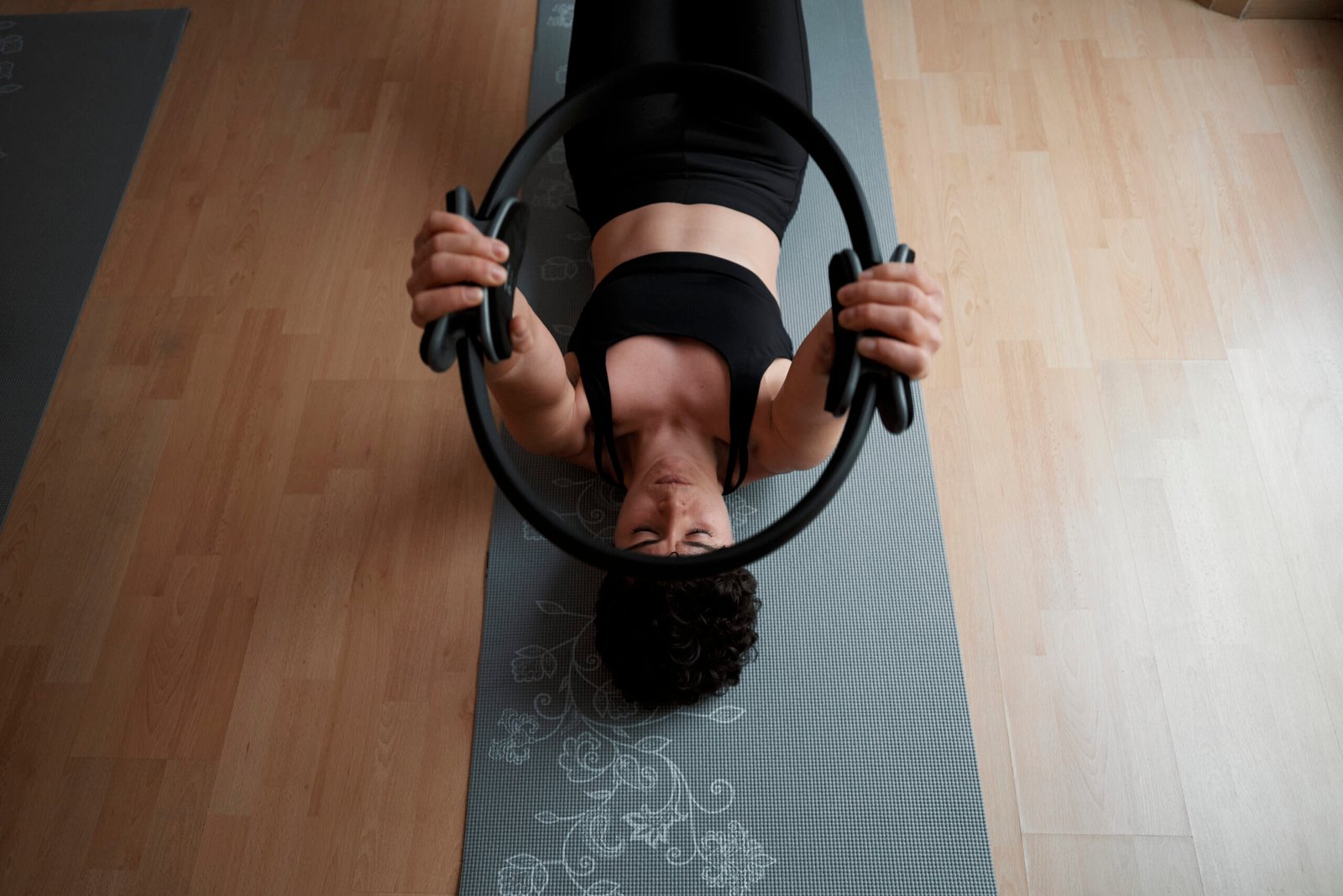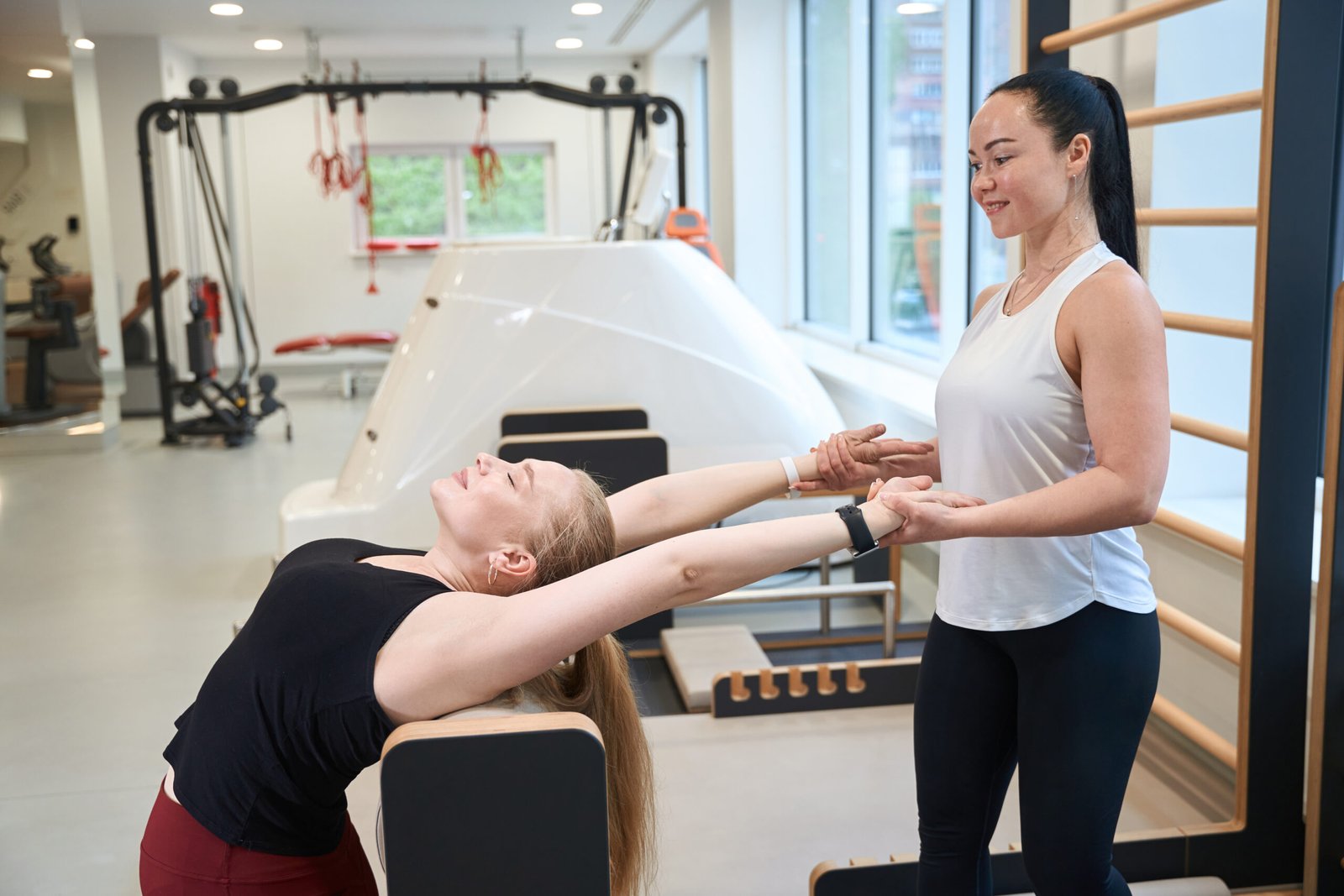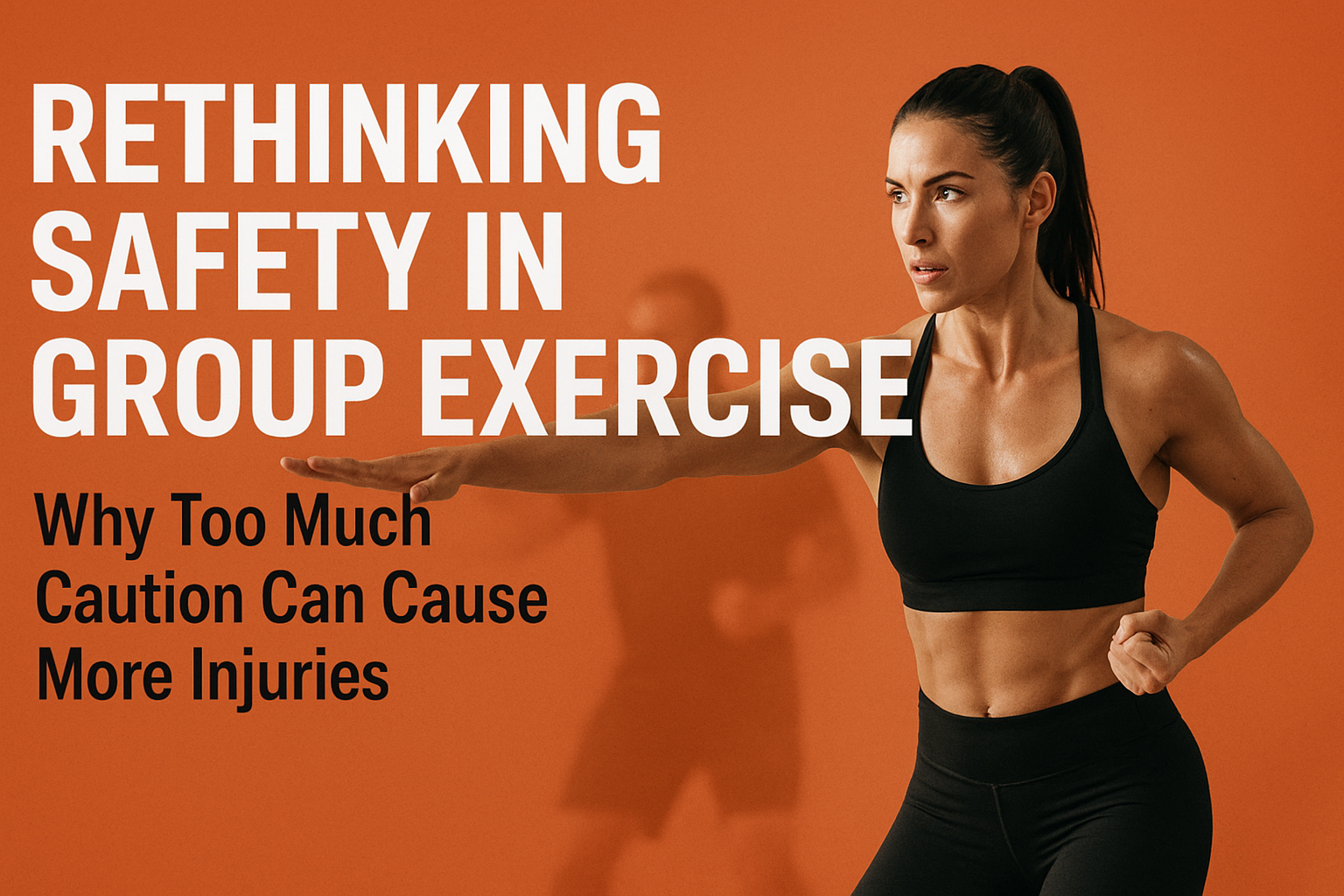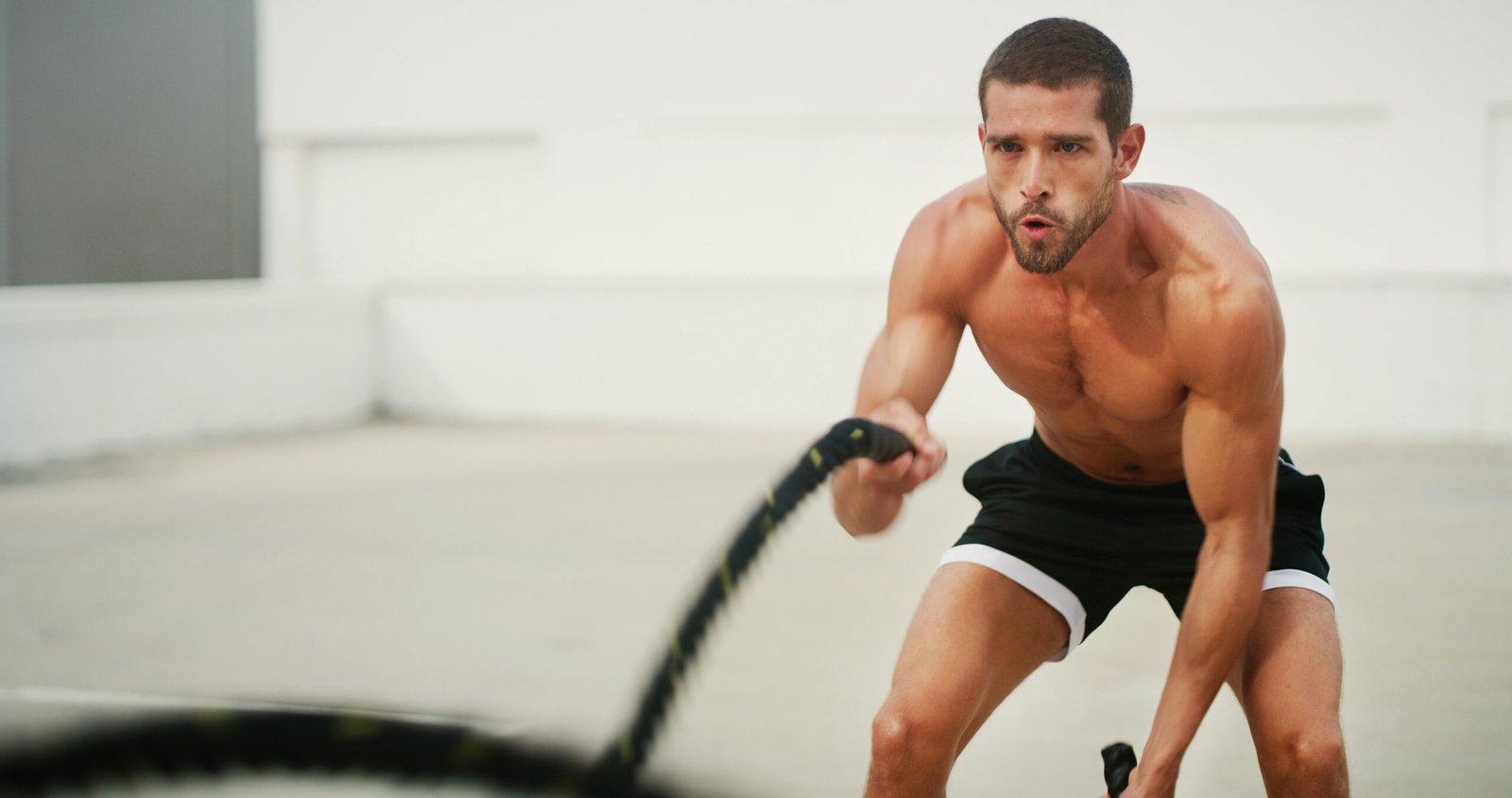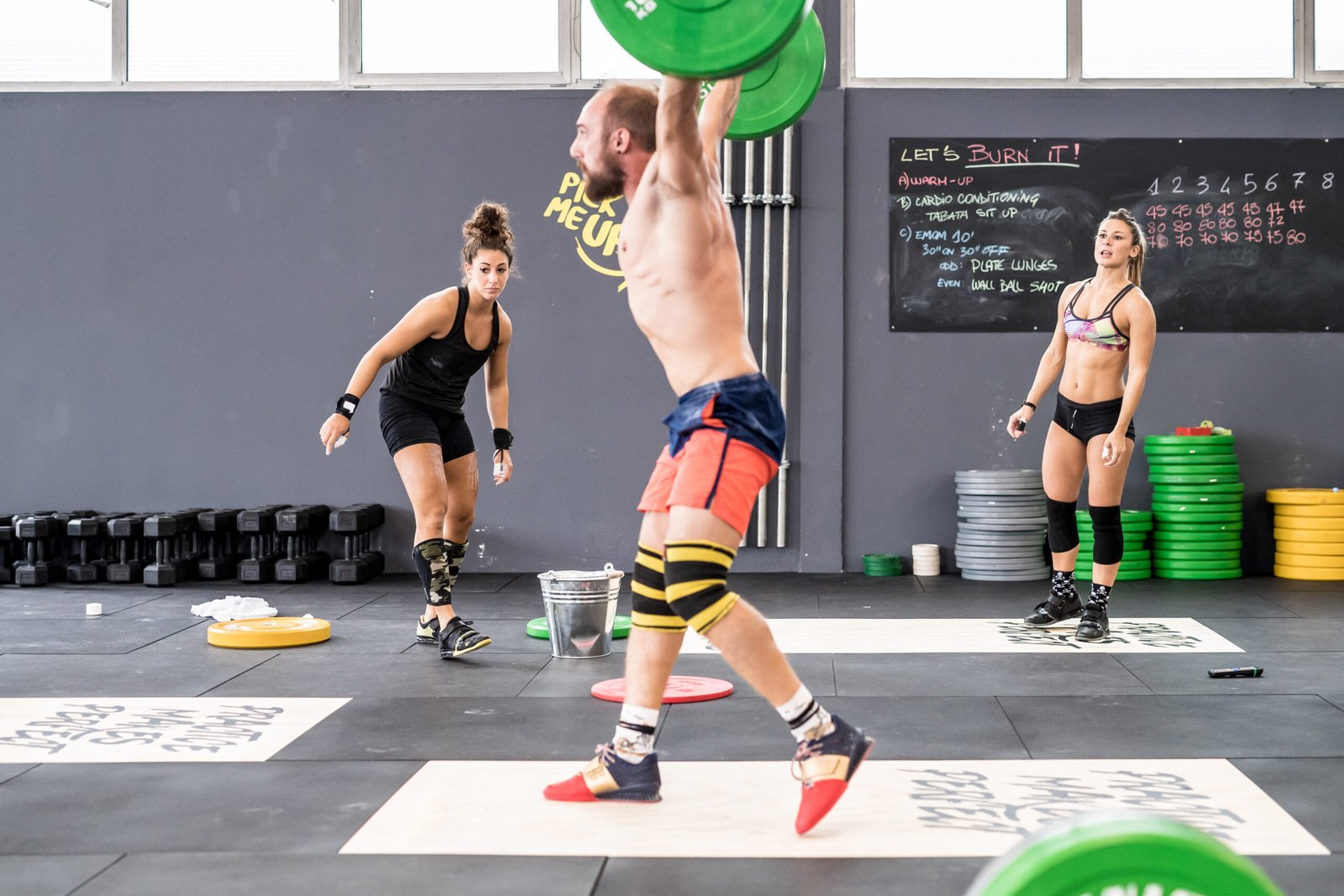When it comes to enhancing physical flexibility and improving the range of motion, Pilates stands out as an exceptional practice. This low-impact exercise, celebrated for its holistic approach, combines strength, posture enhancement, and mental focus. The Role of Pilates in Enhancing Flexibility and Range of Motion isn’t just vital; it’s transformative, especially for individuals of all fitness levels. Let’s delve into how Pilates can unlock incredible benefits, naturally transforming your flexibility and range of motion.
m
How Pilates Enhances Flexibility and Mobility
| Aspect | Benefit | How Pilates Enhances Flexibility and Mobility | Examples of Exercises |
|---|---|---|---|
| Dynamic Stretching | Increases Flexibility | Pilates incorporates dynamic stretching techniques that lengthen muscles through controlled, fluid movements, promoting flexibility. | Roll-Up, Spine Stretch Forward, Saw |
| Controlled Movements | Improves Range of Motion | The slow and controlled movements in Pilates allow the muscles to move through their full range of motion, enhancing joint flexibility and mobility. | Leg Circles, Swimming, Corkscrew |
| Core Engagement | Supports Posture and Mobility | Pilates focuses on strengthening the deep core muscles, which provide stability and support for the spine and pelvis, improving overall posture and movement efficiency. | The Hundred, Plank, Bridge |
| Spinal Alignment | Prevents Stiffness | Pilates emphasizes proper spinal alignment, which directly affects flexibility by encouraging the spine to move through a full range of motion without stiffness. | Spine Stretch, Roll-Down, Mermaids |
| Breathing Techniques | Facilitates Muscle Relaxation | Deep breathing techniques help release muscle tension, encouraging elongation and improving the range of motion in the muscles and joints. | Pilates Breathing in exercises like the Saw, Swan Dive, and Roll-Up |
| Joint Mobility | Improves Flexibility and Fluid Movement | Pilates exercises promote synovial fluid production, which lubricates joints, allowing for smoother and more fluid movements, enhancing joint mobility. | Hip Circles, Spine Twist, Open Leg Rocker |
| Muscle Lengthening | Enhances Muscle Elasticity | Pilates stretches muscles dynamically while also strengthening them, leading to increased elasticity, flexibility, and range of motion. | Hamstring Stretch, Leg Pull Front, Seated Forward Fold |
| Targeted Stretching | Improves Specific Flexibility Areas | Pilates exercises often focus on specific muscle groups or joints, helping improve flexibility in areas that may be tight or restricted. | Swan Dive, Mermaid, Shoulder Bridge |
| Mobility and Flexibility Balance | Promotes Overall Fluidity | Pilates balances flexibility with strength, ensuring that muscles are not only lengthened but also able to support the body in its full range of motion, preventing injury. | Roll-Up, Saw, Swimming |
| Adaptability to Flexibility Levels | Customized Flexibility Progression | Pilates allows modifications to be made for different flexibility levels, ensuring that individuals at all levels can improve their range of motion without pushing too hard. | Chair Pilates, Reformer Stretching, Modified Roll-Up |
One of the outstanding elements of Pilates is its inclusion of dynamic stretching and controlled movements, which are instrumental in increasing flexibility and joint mobility. This exercise regimen is structured to lengthen and strengthen muscles, which is crucial for achieving a wider range of motion. At the heart of Pilates are core-focused exercises that support spinal alignment and improve posture, which directly contributes to enhanced mobility.
In Pilates, the breathing techniques are not just about oxygen intake but are pivotal in sending important cues of relaxation and elongation to the muscles, making them more flexible over time. What further sets Pilates apart is its adaptability, allowing personalized modifications that cater to individual flexibility levels, thereby encouraging gradual improvement. Through regular practice, not only do Pilates enthusiasts notice increased flexibility, but they also enjoy a surge in mobility and overall well-being.
– Dynamic Stretching: Each session engages muscles through various stretching techniques that promote flexibility.
– Controlled Movements: Carefully crafted exercises ensure that you are not just stretching but doing so methodically to improve form.
– Core-Focused Exercise: Many workouts target the core, indirectly aiding in proper alignment and increasing flexibility.
– Deep Breathing Techniques: Facilitates increased oxygen flow, assisting in muscle relaxation and subsequent flexibility.
– Personalized Modifications: Exercises can be adapted to meet different levels, promoting gradual improvement.
Overall, Pilates can be a game-changer for your flexibility, as its principles are deeply ingrained in promoting better muscle control and increased motion.
1. What Are the Benefits of Pilates for Flexibility?
| Benefit | Explanation |
|---|---|
| Lengthening and Strengthening | Pilates helps elongate muscles, contributing to flexibility improvement. |
| Controlled Movements | Precise exercises enhance muscle elasticity and range of motion. |
| Balanced Development | Ensures even muscle growth, preventing imbalances and injury risk. |
| Low-Impact Accessibility | Suitable for all, offering gradual flexibility gains without joint strain. |
| Reduced Stiffness | Promotes fluidity in motion and reduces muscle tension and rigidity. |
The benefits of Pilates extend beyond a mere exercise routine; it fundamentally boosts physical flexibility. By focusing on lengthening and strengthening muscles, Pilates facilitates increased flexibility over time, improving muscle elasticity and joint mobility. Moreover, the deliberate, controlled movements along with integrated breathwork inherent to Pilates help in achieving overall smoothness in motion and reducing the stiffness and tension that impede fluidity.
Regular Pilates practice plays a crucial role in balanced muscle development and reduces the risk of imbalances that could cause injuries. Thanks to its low-impact nature, Pilates is accessible for all ages and fitness levels, which means everyone has the opportunity to improve flexibility through this innovative exercise method. As muscles become more pliable, the body naturally moves with ease, fostering a sense of fluidity in everyday activities.
– Lengthening and Strengthening: Pilates works by elongating muscles, lending to flexibility improvements.
– Controlled Movements: Precision improves elasticity and ensures each stretch benefits the body’s motion range.
– Balanced Development: Prevents uneven muscle growth, which can otherwise lead to injury.
– Low-Impact Accessibility: Suitable for all, allowing steady flexibility gains.
– Reduced Stiffness: Encourages fluidity and ease in motion through regular practice.
These benefits make Pilates a highly recommended practice for those looking to improve flexibility, offering a welcoming approach to enhance physical capabilities.
2. How Does Pilates Improve Mobility?
| Aspect | Details |
|---|---|
| Controlled Movements and Stretching | Focuses on improving joint flexibility and overall mobility. |
| Target Deep Muscles | Strengthens muscles around joints, enhancing overall mobility. |
| Spinal Alignment | Prevents stiffness and promotes smooth, free movement. |
| Increased Synovial Fluid | Lubricates joints, ensuring fluid motion and reducing joint stiffness. |
| Mindful Breathing | Enhances body awareness and efficiency of movement. |
Pilates isn’t just about getting flexible—it’s a powerful tool for improving mobility. By focusing on controlled movements and stretches, Pilates significantly enhances joint flexibility and overall mobility, making everyday tasks easier and more fluid. The exercises target deep muscles, promoting the strength and balance that are essential for an increased range of motion.
Aligning the spine through Pilates routines also contributes to preventing stiffness, translating to a more liberated movement. Regular Pilates practice stimulates increased synovial fluid production, which is crucial in lubricating joints, thereby allowing smoother motion. Moreover, the practice’s emphasis on mindful breathing enhances body awareness and contributes to more fluid and efficient movement patterns.
– Controlled Movements and Stretching: Work comprehensively on joint flexibility and mobility.
– Target Deep Muscles: Building strength where it’s most needed.
– Spinal Alignment: Essential in avoiding stiffness and aiding fluid movement.
– Increased Synovial Fluid: Promotes joint lubrication for smooth motion.
– Mindful Breathing: Enhances movement fluidity and efficiency.
Pilates addresses mobility issues holistically, making it an indispensable part of an active lifestyle for anyone looking to enhance their movement freedom.
3. What Is the Difference Between Flexibility and Mobility?
| Aspect | Flexibility | Mobility |
|---|---|---|
| Definition | Ability to stretch muscles and tissues. | Movement of joints through their range of motion. |
| Primary Focus | Muscles and tissues elongation. | Joint stability and movement efficiency. |
| Pilates’ Role | Enhances muscle elasticity and flexibility. | Improves joint stability, ensuring smooth motion. |
| Result | Improved muscle stretch and flexibility. | Enhanced joint mobility and fluidity of movement. |
Flexibility and mobility, though closely related, have distinct roles in physical health. Flexibility refers to the ability of your muscles and tissues to stretch, whereas mobility involves the movement of joints through their entire range of motion. Both are fundamental for overall physical health and performance, though they emphasize different movement and function aspects.
Pilates enhances flexibility by elongating and strengthening muscles, improving muscle elasticity. It also boosts mobility by promoting joint stability and facilitating smooth, controlled movements. Together, improved flexibility and mobility contribute significantly to better posture, balance, and a reduced risk of injury. Understanding this difference is essential for a structured approach to personal health and performance.
– Flexibility: Muscle and tissue stretching ability.
– Mobility: Concerns joint motion range.
– Pilates’ Role in Flexibility: Helps elongate and strengthen muscles.
– Mobility Enhancements: Focuses on joint stability and controlled movement.
– Increased Benefits: Better posture, balance, and reduced injury risks.
By doing Pilates, you aren’t just stretching muscles—you’re nurturing a healthier, more balanced body that’s equipped to handle life’s physical demands.
4. What Pilates Exercises Enhance Flexibility?
| Exercise | Target Area | Flexibility Focus |
|---|---|---|
| Roll-Up | Spine and back muscles | Lengthens spine, improves flexibility in back and core. |
| Spine Stretch Forward | Spine and hamstrings | Lengthens spine and hamstrings, enhances lower body flexibility. |
| Saw | Spine, hamstrings, and hips | Improves flexibility in the torso and hip joints. |
| Open Leg Rocker | Core, spine, and hamstrings | Increases flexibility in hips and spine while engaging core. |
| Corkscrew | Core, hips, and lower body | Promotes spinal rotation and improves hip flexibility. |
| Swan Dive | Chest, back, and side body | Enhances extension and lateral stretches for chest and side. |
| Mermaid | Side body and chest | Improves lateral flexibility and stretches the torso. |
Several Pilates exercises are particularly effective in enhancing flexibility. The “Roll-Up” and “Spine Stretch” are foundational movements designed to lengthen and strengthen the spine and back muscles. Such exercises form the cornerstone of a routine aimed at increasing spinal flexibility. The “Saw” and “Open Leg Rocker” movements, on the other hand, are superb in enhancing flexibility in the hips and hamstrings, contributing significantly to an improved range of motion.
Other exercises like the “Corkscrew” and “Single Leg Kick” target the flexibility of the core and lower body, facilitating smoother and more controlled movements. The “Swan Dive” and “Mermaid” exercises are focused on increasing flexibility in the chest and side body by emphasizing extension and lateral stretches. Incorporating these exercises into a regular Pilates routine can lead to noticeable improvements in flexibility, contributing to enhanced posture and reduced muscle tension.
– Roll-Up Exercise: Focuses on the spine, enhancing flexibility and strength in back muscles.
– Spine Stretch Forward: Targets lengthening of the spine and hamstrings.
– Saw and Open Leg Rocker: Aid lower body flexibility, crucial for motion range.
– Corkscrew and Single Leg Kick: Core-focused, enhancing smoother movements.
– The Swan Dive and Mermaid: Chest and lateral stretch innovators.
These exercises, when performed regularly and correctly, can significantly elevate one’s overall flexibility, adding a new dimension to daily activities.
5. How Can Pilates Improve Core Strength?
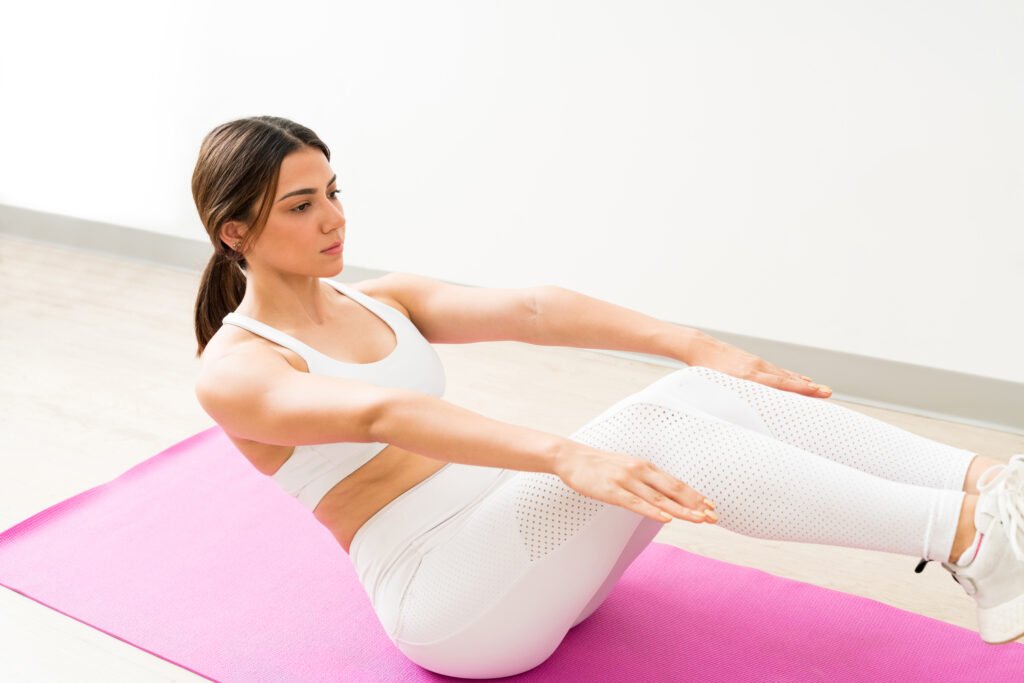
Increasing core strength through Pilates involves targeting deep core muscles, such as the transverse abdominis and pelvic floor, which together lay the foundation for robust core strength. Pilates places a strong emphasis on controlled and precise movements that not only improve muscle endurance but also increase stability in the core region.
Regular engagement in Pilates helps improve posture, alleviates back pain, and mitigates the risk of injury. The practice emphasizes proper alignment and breathing, which is crucial for activating and effectively connecting the core muscles. This targeted approach enhances core strength and supports better balance and movement efficiency in daily activities.
– Target Deep Core Muscles: Essential for building and maintaining strength.
– Controlled, Precise Movements: Improve endurance and stability.
– Posture and Back Pain: Regular practice improves posture and reduces back-related issues.
– Proper Alignment and Breathing: Integral for effective core muscle activation.
– Enhanced Balance: Leads to better coordination in everyday activities.
Thus, Pilates is not just a workout—it’s a comprehensive approach to solidifying the core and improving everyday functional strength.
6. What Is a Good Pilates Routine for Beginners?
| Aspect | Details |
|---|---|
| Foundational Exercises | Focus on exercises that build core strength and stability. |
| Stretch and Lengthen Muscles | Gradually incorporates flexibility-promoting exercises. |
| Low-Impact Movements | Ensures proper form and reduces injury risks for beginners. |
| Incremental Complexity | Exercises become more challenging as comfort and strength grow. |
| Consistency | Regular practice is key to achieving flexibility and mobility improvements. |
For beginners, establishing a good Pilates routine focuses on foundational exercises crucial for building core strength and stability. It’s important to incorporate exercises that gently stretch and lengthen muscles, promoting better flexibility and range of motion over time. Starting with low-impact movements ensures that form is correct, reducing the risk of potential injuries while gaining confidence.
As beginners become more comfortable, they should gradually increase the complexity and intensity of their exercises to continue challenging their bodies in a controlled, safe manner. Consistency is key; aiming for regular practice sessions will maximize the benefits of Pilates in terms of flexibility and relaxation.
– Foundational Exercises: Essential for beginners’ core strength building.
– Stretch and Lengthen Muscles: Promotes flexibility improvements.
– Low-Impact Beginners Movements: Ensures form and reduces injury risk.
– Incremental Complexity: As comfort grows, so can exercise challenges.
– Consistency: Vital for unlocking flexibility and motion improvements.
For those starting out, Pilates offers a structured and safe entry point into a world of improved flexibility and muscle serenity.
7. How Does Pilates Affect Everyday Activities?
| Benefit | Explanation |
|---|---|
| Core Strength and Stability | Improves posture, balance, and overall movement efficiency. |
| Increased Flexibility | Facilitates easier movements in daily tasks like bending and reaching. |
| Body Awareness | Enhances movement precision, reducing the risk of injury. |
| Better Balance and Coordination | Improves coordination, making daily activities more fluid and efficient. |
| Stress Reduction | Breathing techniques in Pilates help reduce mental and physical stress. |
Pilates’ influence extends well beyond the exercise mat, impacting everyday life immensely. By strengthening core muscles, Pilates fosters improved stability and posture, which in turn enhances efficiency in common movements. Increased flexibility through Pilates makes daily tasks such as bending or reaching much easier and more fluid.
An enhanced body awareness, cultivated through Pilates, aids in precise movements, reducing the risk of injury during routine activities. Regular practice develops better balance and coordination, making everyday activities smoother and more confident. Plus, the breathing techniques learned in Pilates help reduce stress, contributing to improved mental focus and overall well-being in daily activities.
– Core Strength and Stability: Directly elevate movement efficiency.
– Increased Flexibility: Facilitates ease in bending and reaching.
– Body Awareness: Ensures precision in movement, reducing injury risk.
– Better Balance and Coordination: Translates to smoother day-to-day activities.
– Stress Reduction: Enhances mental focus and overall well-being.
By incorporating Pilates into your routine, everyday tasks become more than just actions; they become seamless and stress-free.
8. Can Beginners Benefit from Pilates to Enhance Their Range of Motion?
| Benefit | Description | How Pilates Helps |
|---|---|---|
| Low-Impact and Safe | Pilates is a gentle exercise that reduces the risk of injury, making it ideal for beginners. | Pilates uses controlled, slow movements that are easy on the joints, making it accessible for beginners without the risk of overstrain. |
| Gradual Improvement | Pilates allows for steady progress, helping beginners increase their range of motion without rushing. | With consistent practice, Pilates builds muscle elasticity and joint mobility over time, allowing for gradual and sustained improvement. |
| Controlled Movements | Pilates emphasizes slow, deliberate movements, which improve joint mobility and muscle lengthening. | Focused movements like the Roll-Up and Spine Stretch engage muscles in a way that promotes mobility and flexibility, encouraging beginners to move within their range. |
| Tailored Exercises | Pilates exercises can be adjusted to different flexibility levels, offering modifications for beginners. | Instructors can adapt exercises based on a beginner’s range of motion, ensuring exercises are effective while reducing the risk of strain. |
| Core Engagement | Pilates focuses on strengthening the core, which supports better posture and movement efficiency. | A strong core enhances balance, which is essential for increased range of motion, especially when practicing more advanced stretches. |
| Breathing Techniques | Pilates incorporates deep breathing that helps relax muscles and increase their elasticity. | Breathing deeply during exercises helps to release muscle tension, encouraging lengthening and fluidity in movements, aiding flexibility. |
| Increased Muscle Elasticity | Pilates works on both muscle lengthening and strengthening, which is vital for improving flexibility. | Targeted exercises such as the Saw and Open Leg Rocker stretch and strengthen muscles, increasing flexibility in the hips and hamstrings over time. |
| Improved Joint Mobility | Joint mobility is essential for a full range of motion and pain-free movement. | Pilates focuses on joints’ range of motion through fluid, controlled stretches, improving synovial fluid circulation for smoother joint movement. |
| Posture and Alignment | Pilates enhances body awareness, leading to better posture and spinal alignment. | Proper alignment encourages better posture, which helps avoid stiffness, and supports more natural, fluid movements throughout daily life. |
| Motivational Progress | Beginners can easily track their improvements, maintaining motivation for further practice. | By witnessing gradual improvements in flexibility and range of motion, beginners are encouraged to continue practicing Pilates for further progress. |
Pilates is particularly beneficial for beginners aiming to enhance their range of motion. The low-impact nature of Pilates makes it accessible and safe, even for those new to exercise. Through controlled movements and consistent practice, beginners experience improved joint mobility and increased muscle elasticity gradually.
Instructors can tailor exercises to match various flexibility levels, ensuring effective progression and fostering a sense of achievement. As beginners become accustomed to the exercises, they witness marked improvements in motion and flexibility, compelling them to continue and further explore the depths of Pilates.
– Beginner-Friendly: Low-impact and safe for newcomers.
– Controlled Movements: Enhances motion range methodically.
– Tailored Exercises: Matches varying flexibility levels.
– Consistent Practice: Ensures mobility and elasticity growth.
– Gradual Improvement: Beginners gain motivation through noticeable advancements.
For newcomers to physical exercise, Pilates offers a rewarding gateway into a more flexible and mobile lifestyle.
9. What Specific Pilates Exercises Are Best for Increasing Flexibility?
| Exercise | Targeted Area(s) | Description | Flexibility Benefit |
|---|---|---|---|
| Roll-Up | Spine, Back, Hamstrings | This exercise involves slowly rolling the spine up and down while reaching for the toes. It is excellent for spinal mobility and hamstring flexibility. | Improves spinal articulation and flexibility in the back and hamstrings, helping to lengthen and stretch these areas. |
| Spine Stretch Forward | Spine, Hamstrings, Lower Back | While seated, you stretch forward, aiming to touch the toes with a straight back. This targets the lower back and hamstrings. | Stretches and lengthens the spine and hamstrings, relieving stiffness and improving posture. |
| Saw | Spine, Hamstrings, Hips, Shoulders | This dynamic twisting stretch involves rotating the torso and reaching the little toe of each foot with the opposite hand. It stretches the back, hips, and hamstrings. | Enhances spinal rotation and flexibility in the hamstrings, while also increasing flexibility in the hips and shoulders. |
| Open Leg Rocker | Hamstrings, Core, Spine | This exercise combines balance with flexibility, involving rolling the body back and forth while holding the legs extended. | Increases flexibility in the hamstrings, while engaging the core and promoting fluid spine movements. |
| Corkscrew | Spine, Hips, Abdomen | This involves rotating the legs and pelvis while keeping the upper body stable, targeting the abdominal muscles and spine. | Improves spinal rotation flexibility and helps stretch the hip flexors, enhancing mobility and flexibility in the lower back and abdomen. |
| Single Leg Kick | Hamstrings, Quads, Core | Lying on the stomach, this exercise focuses on kicking one leg at a time while engaging the core for balance. It stretches the quads and strengthens the hamstrings. | Stretches the front of the hips and quads while also increasing hamstring flexibility and lower body strength. |
| Swan Dive | Chest, Spine, Abdominals, Hips | Lying on the stomach, the upper body arches upward while the lower body stays grounded. This movement emphasizes chest and hip flexibility. | Expands chest and spine flexibility while strengthening the back and hips. It also promotes a deep stretch in the abdominal muscles. |
| Mermaid | Spine, Side Body, Hips | This lateral stretch involves reaching one arm overhead and stretching the side body, engaging the hips and spine in a dynamic movement. | Increases lateral flexibility and stretches the sides of the torso, improving range of motion and mobility in the spine and hips. |
| Seated Forward Fold | Hamstrings, Lower Back, Spine | Sitting with legs extended forward, the upper body reaches toward the toes to stretch the hamstrings and spine. | Lengthens the spine and hamstrings while relieving tension in the lower back. It also encourages better posture and improved flexibility. |
| Bridge | Spine, Hips, Lower Back, Glutes, Hamstrings | Lying on the back, the hips are lifted while keeping the feet on the floor and the knees bent, engaging the glutes and hamstrings. | Strengthens the glutes and hamstrings, while stretching the hip flexors and improving spinal flexibility and mobility. |
Certain Pilates exercises are exceptional when it comes to enhancing flexibility. The “Roll-Up” exercise targets the spine, delivering stretches that enhance spinal flexibility and strength. The “Spine Stretch Forward” helps in lengthening the spine and hamstrings, thus improving posture and flexibility effectively.
Exercises such as the “Seated Forward Fold” stretch the lower back and hamstrings, promoting an increased range of flexibility in the hips and legs. “Open Leg Rocker” engages the core while simultaneously stretching the spine and hamstrings, aiding significantly in balance and flexibility advancements. Lastly, the “Corkscrew” gets the abdominals and hip flexors involved, enhancing spinal rotation capabilities.
– Roll-Up: Focuses on spinal flexibility and strength.
– Spine Stretch: Lengthens spine and hamstrings for better posture.
– Seated Forward Fold: Addresses lower back and hips, enhancing leg flexibility.
– Open Leg Rocker: Strengthens and stretches, enhancing balance.
– Corkscrew: Advances flexibility in spinal rotation and hip mobility.
Incorporating these exercises consistently into your Pilates routine is sure to amplify your flexibility levels significantly.
10. How Often Should I Practice Pilates to See Improvements in My Flexibility?
| Frequency | Benefit | Recommended Practice | Expected Results |
|---|---|---|---|
| 2-3 times per week | Initial Flexibility Improvements | Practicing Pilates 2-3 times a week is ideal for beginners and individuals looking to see gradual improvements. Each session should be around 45-60 minutes. | Expect to see noticeable improvements in flexibility within a few weeks, especially in terms of mobility and range of motion. |
| 3-4 times per week | Balanced Flexibility and Muscle Strength | For those with a bit more experience, practicing Pilates 3-4 times per week helps build flexibility while improving muscle strength and coordination. | More pronounced flexibility gains will be visible in both the upper and lower body, with a stronger core supporting the movements. |
| 4-5 times per week | Significant Flexibility Gains | This frequency is ideal for individuals aiming for more significant flexibility results. Sessions should include varied exercises for muscle lengthening and stretching. | Greater flexibility in the hamstrings, hips, and spine will develop, with overall mobility enhanced significantly. |
| Daily Practice | Optimal Flexibility | For advanced practitioners, daily Pilates practice provides the highest intensity for flexibility development. Focus on stretching and strengthening exercises. | Maximum flexibility improvements, particularly in the spine, hamstrings, and hips, with enhanced posture and range of motion. |
| Consistency and Regularity | Maintaining Flexibility | Consistency is key. Practicing Pilates regularly ensures continuous improvement and maintenance of flexibility. | Regular practice helps maintain flexibility long-term and reduces stiffness and tightness, ensuring sustained range of motion improvements. |
| Intensity vs. Duration | Focus on Quality | Focus on controlled, precise movements with proper breathing techniques rather than the duration of each session. | Prioritize form and technique over speed to maximize flexibility benefits without risking injury or overexertion. |
| Active Rest Days | Allowing Recovery for Flexibility Growth | Include active rest days, where lighter Pilates movements or other activities (like walking or yoga) are practiced to avoid overtraining. | Active recovery ensures muscle relaxation and prevents burnout, supporting better flexibility gains over time. |
Consistency is crucial when practicing Pilates for flexibility improvements. Ideally, engaging in Pilates sessions at least 2-3 times per week is essential to witness noticeable flexibility advancements. While individual progress may vary, most practitioners experience results within a few weeks of regular commitment.
Ensuring each session is focused on quality rather than quantity maximizes the flexibility benefits derived. Additionally, combining Pilates with other physical activities can enhance overall flexibility and movement range, fostering an all-around improvement.
– Consistency: 2-3 times weekly practice yields results.
– Noticeable Improvements: Expected within several weeks.
– Quality Assurance: Prioritize form to maximize benefits.
– Integrate Other Activities: Enhances comprehensive flexibility.
– Regular Practice: Not just flexibility, but also overall health is improved.
Regular dedication to Pilates is not just about immediate flexibility; it’s about developing a lasting, profound change in how your body moves and feels.
11. Is Pilates Suitable for People with Limited Flexibility or Existing Mobility Issues?
| Feature | Details |
|---|---|
| Gentle Warm-Ups and Modifications | Pilates offers adaptations for individuals with mobility challenges. |
| Improvement in Core Strength | Pilates strengthens core muscles for better stability and balance. |
| Alignment and Posture Correction | Helps improve posture and reduce strain on joints, enhancing mobility. |
| Controlled Movements | Enhances body awareness and prevents injuries by requiring precise movements. |
| Adaptability for All Skill Levels | Exercises can be modified to suit different flexibility and mobility levels. |
| Focus on Breathing Techniques | Breathing aids relaxation and supports proper movement mechanics. |
| Versatility of Equipment | Equipment like resistance bands and chairs provide support during exercises. |
| Enhanced Flexibility Over Time | Pilates progressively improves flexibility, even for those with initial limitations. |
| Safe for Older Adults | Low-impact nature makes Pilates suitable for older individuals with mobility issues. |
| Holistic Benefits | Promotes both physical and mental well-being, supporting resilience. |
In addition to being inclusive for those with limited flexibility, Pilates offers a multitude of health benefits that extend beyond improved range of motion. A regular Pilates practice can aid in the development of core strength, which is crucial for overall body stability and balance. This core-centric workout helps in aligning the spine and correcting postural imbalances, further enhancing mobility over time. Moreover, the emphasis on controlled, precise movements promotes greater body awareness, leading to a reduction in the risk of injury during daily activities or other forms of exercise. As a result, incorporating Pilates into your fitness routine not only assists in enhancing flexibility but also fosters a holistic sense of well-being and physical resilience. These attributes make Pilates a valuable addition to any fitness regimen, appealing to a broad audience ranging from athletes to seniors seeking to maintain an active lifestyle.
– Gentle Warm-Ups and Modifications: Pilates classes often incorporate gentle warm-up routines and offer modifications tailored to individual needs, making it accessible for people with limited flexibility or mobility issues.
– Improvement in Core Strength: Through a series of exercises focused on strengthening the core muscles, Pilates enhances body stability and balance, which is beneficial for those experiencing mobility challenges.
– Alignment and Posture Correction: Pilates emphasizes proper alignment and posture, which can lead to improved mobility by reducing strain on joints and correcting imbalances that hinder movement.
– Emphasis on Controlled Movements: Pilates requires precise, controlled movements, which enhances body awareness and can help prevent injuries in daily activities or other exercise regimes.
– Adaptability for All Skill Levels: Pilates exercises can be adjusted in intensity to cater to beginners or those with physical constraints, while still providing an effective workout that progresses over time.
– Focus on Breathing Techniques: The practice incorporates breathing techniques that promote relaxation and better lung capacity, aiding those with mobility issues to exercise without overexertion.
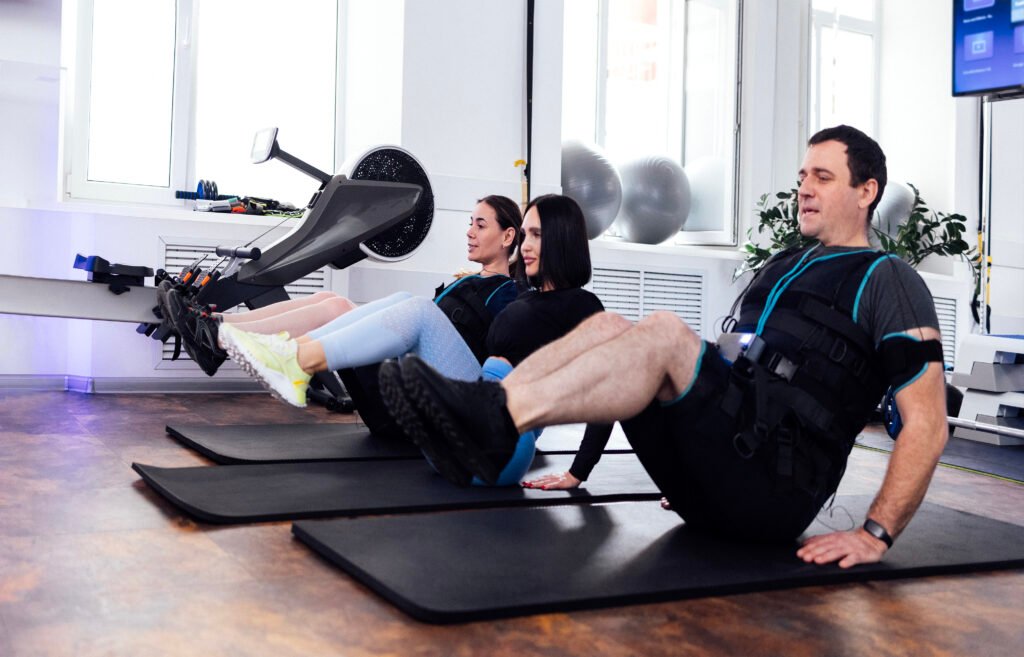
– Versatility of Equipment: Instructors use a variety of equipment, like resistance bands and chairs, which can be adapted to support individuals with mobility limitations during their Pilates practice.
– Enhanced Flexibility over Time: While initially accommodating limited flexibility, regular practice of Pilates gradually increases flexibility, enabling greater ease of movement and range of motion.
– Safe Environment for Older Adults: Pilates is a low-impact exercise, reducing the risk of injury, making it particularly appealing for older adults seeking to maintain an active lifestyle while managing mobility issues.
– Holistic Benefits beyond Physical Fitness: Beyond physical benefits, Pilates promotes mental well-being by encouraging mindfulness, stress reduction, and a sense of achievement, which can be especially beneficial for individuals with physical restrictions.
In conclusion, Pilates emerges as a powerful ally in the pursuit of improved flexibility and an enhanced range of motion. By integrating mindful movements and core strengthening exercises, Pilates not only targets specific muscle groups but also promotes overall body awareness and alignment. Whether you’re an athlete aiming to prevent injuries, someone seeking relief from stiffness, or simply a fitness enthusiast wanting to broaden your physical capabilities, Pilates offers tailored benefits that can be adapted to meet diverse needs. Its emphasis on controlled, precise movements and breathwork not only fosters flexibility but also contributes to better posture and stability, proving that Pilates is much more than just an exercise regime—it’s a holistic approach to maintaining a supple, resilient body. As more people discover its benefits, Pilates continues to gain recognition as an essential component of a balanced fitness routine, underscoring its role in nurturing a body that moves with ease and grace.


